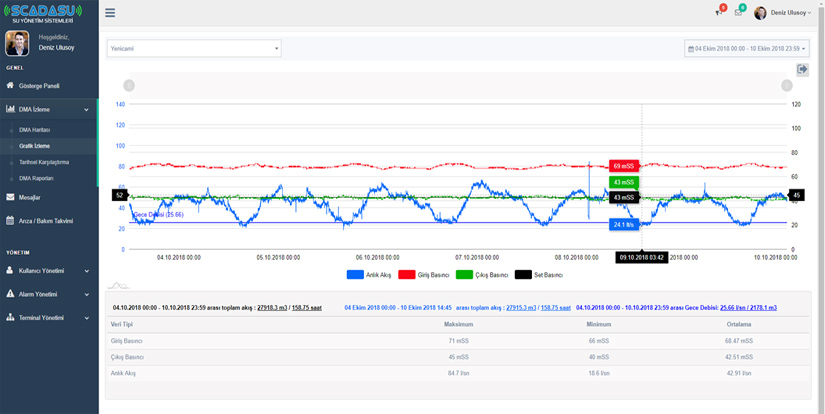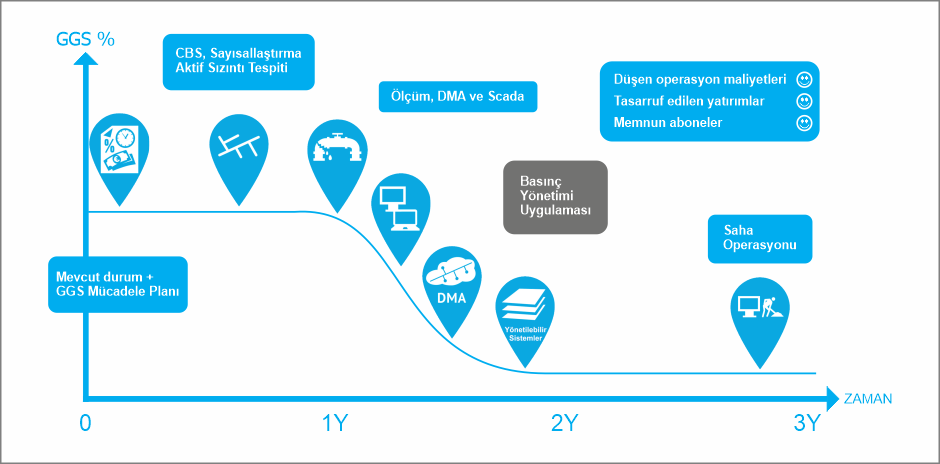Basınç Yönetimi
Basınç yönetimi, iyi yapılandırılmış bir fiziki su kayıpları yönetim stratejisi içinde yer alması gerekli olan temel unsurlardan birisidir. Su dağıtım şebekelerinde oluşan kayıp/kaçak oranı, terfi veya cazibe ile sağlanan basınç ile doğrudan bağlantılıdır. Şebekeniz ölçülebilir değilse yönetilemez. Öncelikle şebeke üzerinde ölçülebilir bölgeler oluşturmak gerekir. Eski tip dağıtım sistemlerindeki borular büyük oranda birbirleri ile bağlantılı olduğu için yönetim ve ölçüm mümkün olmamaktadır.

Şebekenin daha verimli yönetilebilmesi için, DMA (District Metered Area) denilen kendi içerisinde ölçülebilir ve izole bölgelere ayrılması gerekir. Her bölge hidrolik olarak diğer basınç bölgesinden ayrılır ve karşımıza kontrol edilebilir bir şebeke modeli çıkar. Basınç kontrol edilmezse su kayıpları artar ve yüksek basınç nedeniyle arızalar çoğalır. Hidrolik olarak birbirinden ayrılan basınç yönetimi (DMA) bölgelerinde hem kayıpları azaltmak hem de arıza sayısını düşürmek için bölgenin karakteristiğine uygun olarak ihtiyaca göre basınç sağlanmalıdır. Dinamik basınç yönetimi uygulaması ile birlikte gece debisi takip edilmeli ve yönetim bu doğrultuda devam etmelidir.
Aktif sızıntılar tespit edilerek hat üzerindeki sızıntı noktaları tamir edilmelidir. Eldeki sayısal veriler üzerinden şebeke üzerinde gezilerek, özellikle gürültünün az olduğu saatlerde akustik dinlemeler yapılarak, sızıntı noktaları tespit edilmelidir. Tespit edilen sızıntı noktalarının tamir edilmesi su kayıplarının azalmasında önemli bir unsurdur. Periyodik olarak uygulanması gereken bir işlemdir.

Nasıl Uygulanır?
Hat üzerine oluşturulan by-pass bölgesinde bulunan Yönetim Yazılımı ve basınç sensörlerinden elde edilen değerler, SCADASU Elektronik BKV Kontrolörü tarafından anlık olarak değerlendirilip, basınç kontrol vanasına açma ya da kapama yönünde komut göndermesi ile hattaki basıncın istenilen değerde tutulması sağlanır. BKV Kontrolörü Yönetim Yazılımı ve basınç sensörlerinden aldığı verileri değerlendirerek basınç kontrol vanasına kumanda etmektedir.
BKV Kontrolörü, şebeke üzerinden elde ettiği giriş basıncı, çıkış basıncı, anlık akış, toplam akış ile ünite içersindeki batarya seviyesi ve harici enerji kaynağının seviyesini belirlenen periyotlarda sistem merkezine göndermektedir. BKV Kontrolörü içerisinde bulunan GSM iletişim modülü, sistem merkezi ile sürekli on-line bağlantıda kalmaktadır. İletişim kesilmesi durumunda kendi içinde kayıt tutmakta, iletişim tekrar sağlandığında tüm verileri tekrar merkeze göndermektedir.

Su Kayıpları ve Şebeke Arızaları Azalır
Yukarıdaki grafikte görüldüğü gibi, gelir getirmeyen su (kayıp su) miktarı basınç yönetimi uygulaması ile birlikte azalmaya başlar. Su kayıplarının azalmasıyla birlikte saha operasyon maliyetleri de ciddi oranda azalmaktadır. Şebeke arızaları ciddi oranda azalır. Su ile birlikte yeni yatırım planlarında da tasarruf sağlanmaya başlar. Müşteri memnuniyeti sağlanmış olur.
BKV Kontrolör Kullanımı
Su kayıpları azaltma projelerinde azami verim elde etmenin yolu basınç yönetimini BKV Kontrolör ile yapmaktır. BKV Kontrolörü basınç yönetimnde esneklik ve kolaylık sağlamaktadır. Birden fazla basınç yönetim modeli sunar. DMA karakteristiğine en uygun model ile bölge basıncı yönetilebilir. Tüm şebeke olayları uzaktan izlenebilir ve kontrol edilebilir.
- Akışa Duyarlı Basınç Yönetimi
- Tarifeli Basınç Yönetimi
- Kritik Nokta Basınç Yönetimi
- Sabit Basınç Yönetimi
Bölge basıncı, debimetreden alınan akış verisine göre yönetilir. Akış tablosuna bölge basıncının hangi akış değerinde kaç olması gerektiği bilgisi önceden hesaplanarak yazılır. BKV Kontrolörü anlık akış bilgisini tablo ile karşılaştırarak çıkış basıncını sürekli revize eder. Bu yöntem bilinen en verimli basınç yönetim modelidir. Akışın düşük olduğu gece saatlerinde bölge basıncı minimum seviyede tutularak su kayıplarının azaltılmasında en iyi verim elde edilir.
Bölge basıncı, tarife tablosunda belirtilen zaman ve basınç değerlerine göre ayarlanır. BKV Kontrolörü tarife tablosundaki zaman dilimlerinde belirlenen çıkış basıncı setine göre basınç kontrol vanasına kumanda eder. Bir gün içerisinde 10 adet farklı zaman dilimi için basınç set değeri girilebilir. Ayrıca haftanın farklı günleri için farklı zaman-basınç ayarlı tablolar oluşturulabilir.
Bölge içerisindeki en yüksek kota sahip olan konum kritik nokta olarak belirlenir. Bu konumda bir kritik nokta veri kaydedicisi çalıştırılır. Kritik nokta veri kaydedicisi ölçtüğü basınç bilgisini BKV Kontrolöre ulaştırır. BKV Kontrolör ise gelen basınç verisini değerlendirerek kritik noktada sağlanması gereken basınç değerini hedef olarak belirleyerek kontrol yapar.
Bölge içerisindeki basıncın sabit bir değerde tutulması gerektiği durumlarda kullanılır. BKV Kontrolör sabit basınç set değerine göre bölge basıncını sürekli aynı seviyede tutar. Giriş basıncı ne kadar yükselirse yükselsin, çıkış basıncı hep aynı kalır.
Sabit basınç yönetimi bölge karakteristiğine göre uygulanması gereken bir modeldir. Diğer modellerde olduğu gibi su kayıplarının ve şebeke arızalarının önemli oranda azalmasını sağlar.

